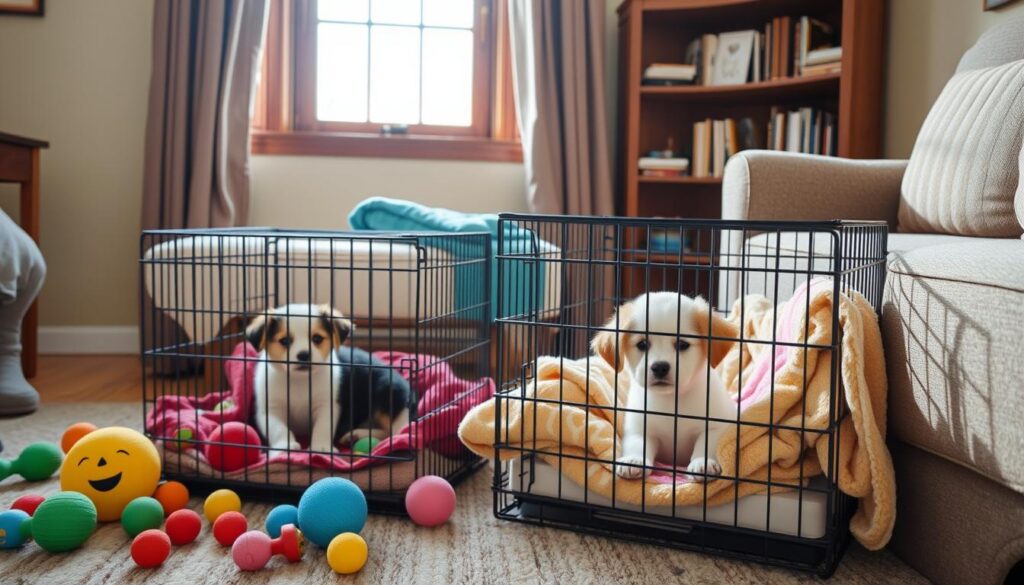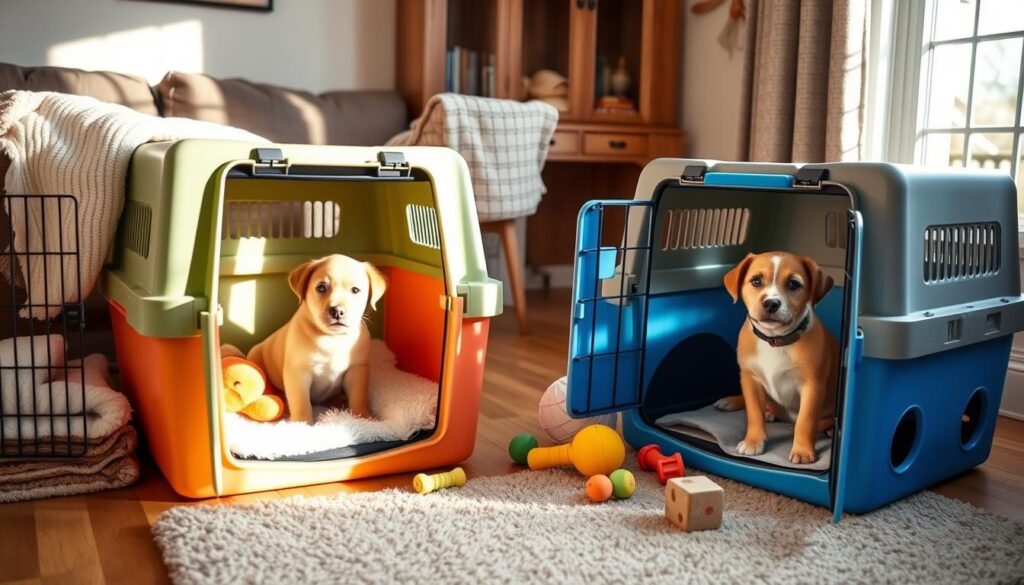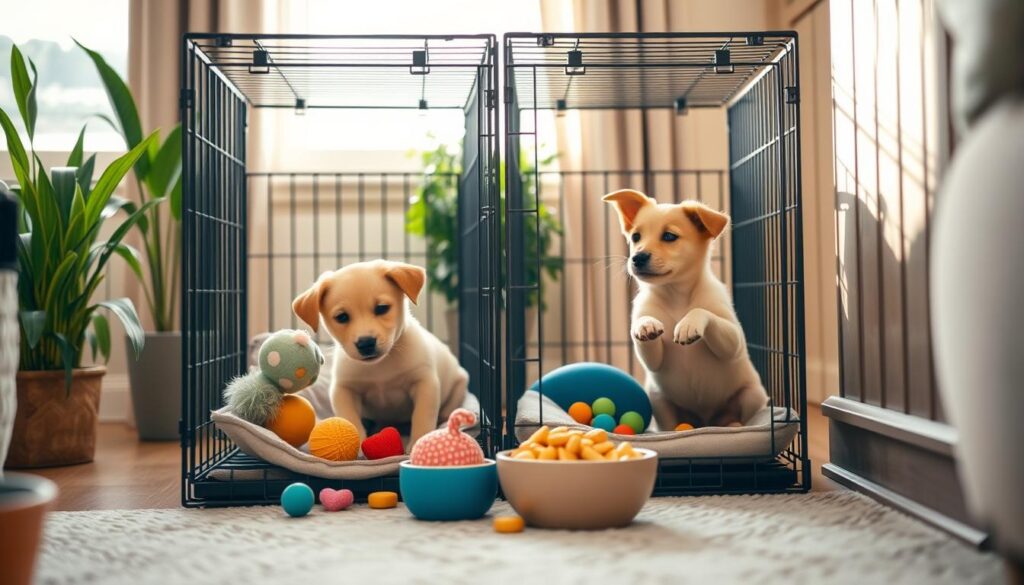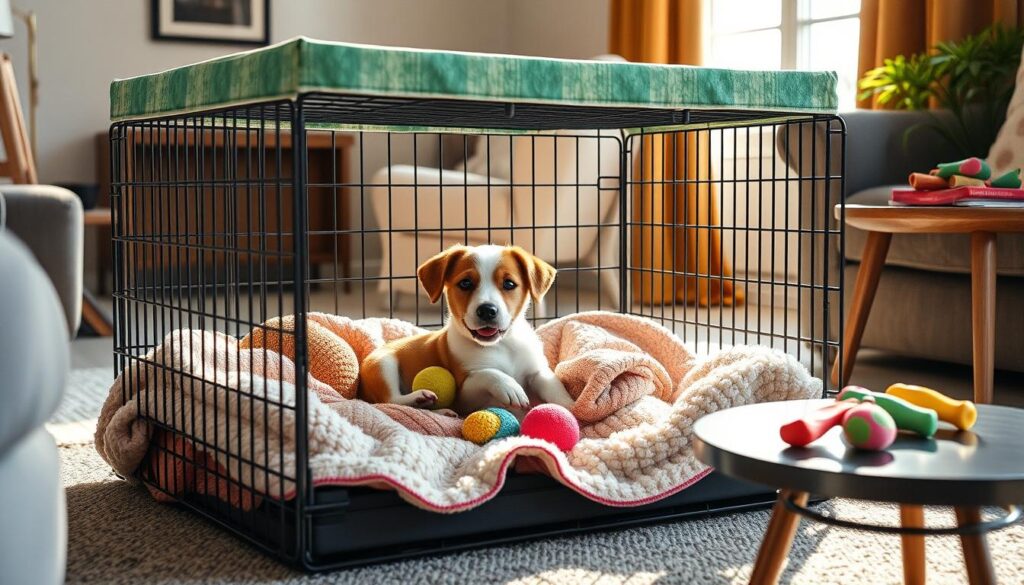How To Crate Train Two Puppies – A Beginners Guide

Getting new puppies is fun, but it’s also a big challenge. Training two puppies in a crate needs patience and steady effort. This guide will show you how to crate train two puppies together. It will make sure you and your puppies have a good time.
Key Takeaways
- Crate training requires patience and consistency
- Never use crates for punishment
- Limit crate time for puppies under 6 months to 3-4 hours
- Create a positive association with the crate
- Adapt training to each puppy’s individual needs
- Expect the training process to take days or weeks
Preparing For Crate Training
Preparing for crate training two puppies needs careful planning. You must choose the right dog crates and create a cozy space for each. This is crucial for successful training and happy pets.
Types of Crates Available
Pet stores like Petco or Amazon have many puppy crate options:
- Plastic crates (flight kennels)
- Fabric crates with collapsible frames
- Metal wire pens
Choosing the Right Crate Size
Choosing the right crate size is important. Your puppy should be able to move around easily. For growing pups, pick a crate that will fit their adult size. You can use dividers to adjust the space as they grow.
Setting Up the Crate Environment
Put each crate in a family area where puppies can feel included like in a living room, nursery or the bedroom. Add soft blankets or beds to make the crates cozy and start by keeping the doors open so your pups can explore freely. This crate training approach helps puppies see their crates as safe spaces.
Remember, crate training two puppies is extra work. Start with separate crates to avoid littermate syndrome. This way, each pup learns to be independent and bonds with you, not just their sibling.
Understanding Littermate Syndrome
Raising multiple puppies can be tough. It’s key to know the challenges that come with it. Littermate syndrome is a behavior issue that affects puppies raised together, often siblings.
Definition and Characteristics
Littermate syndrome happens when two puppies bond too closely. This can cause fear of new things, hard training, and too much dependence on each other. Research shows that these puppies may have trouble with humans and other dogs.
Causes and Contributing Factors
Several things can lead to littermate syndrome:
- Lack of individual attention from owners
- Limited socialization outside the pair
- Constant companionship between puppies
- Insufficient separate training and playtime
To avoid littermate syndrome, introduce puppies one at a time. If you have two, make sure they spend time apart and they should sleep in separate crates and get individual training. This helps them be independent and have good social skills.
Management and Prevention of Littermate Syndrome
Training Strategies
It’s important to use good littermate training methods. Each puppy needs their own training time. They should go to different classes for 2-3 hours each week or if you crate train them at home do it separately. This helps them learn and feel confident on their own.
Socializing them is also crucial. Take them on more outings, to dog parks both alone and together. This lets them learn from others and bond with family members.
Crate Training Considerations
Crate training is very important for littermates, but they should have their own crates to avoid relying too much on each other. This helps them feel secure when they’re apart.
| Training Aspect | Recommendation |
|---|---|
| Crating | Separate crates for each puppy |
| Training Classes | 2-3 hours weekly per puppy |
| Socialization Trips | Triple the usual amount |
| Playtime | Limited between puppies, more with humans |
Stopping littermate syndrome takes a lot of work but is worth it. By using these strategies, you’ll help your puppies grow up happy and well-trained.
Establishing a Training Routine

Creating a consistent dog training routine is key for crate training two puppies. A structured puppy schedule builds positive crate associations and good behavior.
Daily Crate Schedule
Your crate training schedule should include regular meal times, potty breaks, and playtime outside the crate. Feed your puppies near or inside their crates to create positive associations. Start with short crating periods while you’re home.
| Time | Activity |
|---|---|
| 7:00 AM | Wake up, potty break |
| 7:30 AM | Breakfast in crate |
| 8:00 AM | Playtime |
| 9:00 AM | Crate time (30 minutes) |
| 12:00 PM | Lunch, potty break |
| 2:00 PM | Crate time (1 hour) |
| 5:00 PM | Dinner in crate |
| 8:00 PM | Final potty break |
| 9:00 PM | Bedtime in crate |
Using Cue Words
Incorporate cue words into your training routine. Use a command like “kennel up” or ”crate” consistently. Reward your puppies with treats or praise when they respond correctly.
Remember, consistency is key in your crate training schedule. Stick to your routine and use cue words regularly. With patience and persistence, your puppies will soon view their crates as safe, comfortable spaces.
Gradual Confinement Techniques

Crate training is key for puppy success. It helps puppies get used to their crates without stress. This method prevents separation anxiety and makes crate time good.
Short Duration Practice
Begin with 5-minute crate sessions. Increase by 2-3 minutes each day. This builds confidence in the crate.
Handling Separation Anxiety
Practice leaving puppies in crates for short times. Make your exits calm to avoid stress. Gradually increase your time away.
| Week | Crate Time | Treat Frequency |
|---|---|---|
| 1 | 5 minutes | Every 30 seconds |
| 2 | 10 minutes | Every 45 seconds |
| 3 | 15 minutes | Every 60 seconds |
Consistency is key in training. These steps make crates safe and comfy for puppies. To learn more about crate training visit our ”How To Crate Train a Puppy” article. It will describe in detail how to do it correctly.
Troubleshooting Common Issues

Crate training two puppies can be tough. Many new dog owners face issues during this time. Let’s look at common problems and how to fix them.
Addressing Reluctance to Enter the Crate
If your puppies don’t want to go in their crates, try these tips:
- Use high-value treats like chicken or cheese to entice them. My dog loves plain cooked chicken breast.
- Place their favorite toys inside the crate
- Never force them in – patience is key
Managing Excessive Barking or Whining
Dog whining can be tough. Here’s how to handle it:
- Determine if it’s a legitimate need (potty break) or attention-seeking
- Ignore attention-seeking whines to avoid reinforcing the behavior
- Respond to genuine needs promptly
- Avoid punishing or yelling, as it may increase anxiety
About 40% of new dog owners struggle with crate training. It’s normal for puppies to take time to adjust. Some may need up to 2.5 hours to settle down. If problems last after a few weeks, consider getting help from a Certified Professional Dog Trainer.
Ensuring a Positive Experience Long-Term

Crate training success means making a safe, comfy space for your puppies. Follow these tips to make their crates cozy spots, not just places to stay.
Maintaining Crate Use as a Safe Space
Make the crate as inviting as possible. Use your pups favorite toys, treats or blankets. Praise them when they enter the crate. They should feel really good around and in the crate. That wya they will understand that the crate means playtime, food and/or security and trust me then they will never leave the crate.
To introduce the crate, start with short crate times, even when you’re home. This helps them see crates as safe, not just for when you’re away. As they get older, you can increase the time they spend in the crate.
- Choose a size allowing standing, turning, and lying down
- Place in family areas, not isolated spots
- Provide clean water and engaging toys
- Ensure good ventilation and comfortable temperature
| Puppy Age | Max Crate Time |
|---|---|
| 8-16 weeks | 2-3 hours |
| 4-12 months | 4-5 hours |
By using these crate training tips, you’ll make crate time a positive experience for your puppies. Remember, being patient and consistent is key to success!
Nighttime Crate Training for Two Puppies
Training puppies to sleep at night can be tough, especially with two but doing so is key to raising good dogs. Place the crates in your bedroom so you can hear them and they can sense you.
Make a bedtime routine for your puppies, take them out for a last potty break before they go in their crates. Try not to give them food or water right before bed to avoid accidents. Don’t worry they will make themselves known if they are thirsty.
- Use separate crates to prevent littermate syndrome
- Ensure crates are the right size for comfort
- Gradually move crates to desired locations as puppies mature
- Ignore whining unless it’s clear your puppy needs something
Consistency is crucial in training puppies to sleep at night. With patience and the right methods, your puppies will learn to sleep in their crates.
| Age | Maximum Nighttime Crating Duration | Recommended Potty Breaks |
|---|---|---|
| 8-10 weeks | 4-5 hours | 1-2 times |
| 11-14 weeks | 5-6 hours | 1 time |
| 15-16 weeks | 6-8 hours | 0-1 times |
| 17+ weeks | 8+ hours | 0 times |
Avoiding Common Mistakes in Crate Training Multiple Puppies
Neglecting Individual Attention
One big mistake is not spending enough time with each puppy alone. This can make puppies too attached to each other, with 75% of new puppies getting too close to their littermates.
To fix this, spend quality time with each puppy by themselves. This means individual training, play, and potty trips. If you life alone keep one puppy in the crate and play with the other but make sure the crated puppy has a toy or some kind of entertainment. When you are done, swap out the puppies.
If you life with a partner and/or have kids, one person can take care of one puppy and then you simply swap out the puppies.
Failing to Set Boundaries
Another mistake is not setting clear rules. This can make puppies too dependent on each other, with can result in separation anxiety. Here are some tips to avoid this:
- Use separate crates for each puppy
- Stagger crate release times for individual attention
- Ensure visual separation between crates to reduce fussiness
By using these methods, your puppies will learn to be independent. This reduces the chance of them getting too attached. Remember, with the right training and bonding, 8 out of 10 homes see a healthy dog pack after a few months.
| Common Mistake | Percentage of Owners | Solution |
|---|---|---|
| Neglecting individual attention | 90% | Schedule daily one-on-one time |
| Allowing over-attachment | 75% | Use separate crates and training sessions |
| Ignoring separation anxiety | 60% | Practice gradual separation techniques |
| Skipping individual training | 25% | Implement separate training routines |
Transitioning to More Freedom Outside the Crate
As your puppies show crate training progress, it’s time to expand their freedom. Start by puppy proofing one room at a time. This gradual approach ensures safety while allowing your pups to explore their new world.
Begin with short supervised periods outside the crate. For smaller dogs, start with 1-2 hours of free time. Larger breeds can handle 2-3 hours initially. Over two weeks, aim to increase free time to 5-6 hours while reducing crate time to just 30 minutes.
Use baby gates or playpens to create safe zones. That way you can supervise your puppies easily. Remember, don’t rush this process. Add one room per month, based on good behavior. Many dog owners have learned the hard way that too much freedom too soon can lead to destroyed furniture and lost shoes.
I remember one time when I let my dog out and he ran straight to my shoes. Puppy teeth are sharp and my shoe was riddled with holes.
Keep using the crate for rest periods and when you can’t supervise. This maintains the crate as a safe space and prevents accidents. Feed meals in the crate to reinforce positive associations. Gradually increase crate-free time as your puppies prove trustworthy.
- Start with one room at a time
- Use baby gates for safe zones
- Increase freedom gradually
- Continue using crate for rest and unsupervised times
By following these steps, you’ll ensure a smooth transition from crate to house freedom for your puppies.
Conclusion
Training two puppies to use a crate needs a lot of work and a plan that fits them. Use puppy raising tips to make a peaceful home for all dogs. Every puppy is different, so you must change your plan to meet their needs.
Buying good crates, which cost $400 to $500, is key for your puppies’ happiness and safety. With hard work, your puppies might learn to go into their crates in a week or two. But, don’t rush it or give them too much freedom too fast. This can cause problems or even dangerous actions.
When you have two puppies, give each one your full attention and train them separately. This stops issues like Littermate Syndrome and helps them grow on their own. By mixing group time with one-on-one care, you’re preparing them to be well-adjusted adult dogs in your home.


